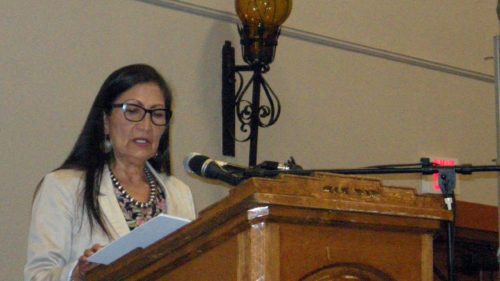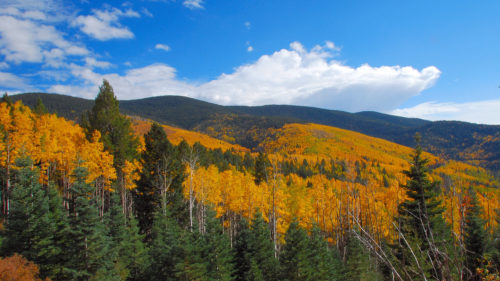(This story first appeared in the Summer 2014 Outdoor Reporter)
By Jim Bates, Special to New Mexico Wildlife Federation
“I think that’s number 25,” I said to my turkey hunting buddy Dick as we got back into my pickup and headed on down the forest road.
“Wow, this is incredible. I’ve never heard so many gobblers in my life!” Dick responded.
What was even more incredible was the fact that we were “putting gobblers to bed” along a main thoroughfare running through Lincoln National Forest.
Gobbling turkeys were everywhere on this eve of the start of the spring turkey season. What was particularly encouraging, though, was that this was not some isolated hotspot or wildly unusual incident. It was only a single example that turkeys are doing well in many locations in our state.
New Mexico has always had a fairly stable turkey population. Even in the grim years following the end of market hunting which decimated wild turkey numbers in most of the country, the numbers here seemed to have fared better than most. Isolated pockets of our native Merriam’s turkeys survived in our mountain ranges, and once they had been afforded the proper protection of enlightened game management their numbers slowly started to increase. By the 1950s turkeys had recovered so well that licenses to hunt them were sold over the counter along with a deer and bear license, although turkey hunting was limited to the fall.
With the advent of spring gobbler hunting and its geyser-like rise in popularity across the country in the 1960s, an entirely new outlook toward wild turkeys as a game species took hold. New Mexico started its first experimental spring gobbler hunts in the mid-1960s. Because spring hunting was a relatively new phenomenon, game managers didn’t have a lot of data to back the supposition that the birds could be hunted in the spring without impacting overall turkey numbers.
Hence, the first 10 years or so of spring turkey hunting were carefully monitored, short-season affairs with limited permits allotted by drawing in limited areas for our Merriam’s subspecies. In fact, at that time the Merriam’s was thought to be the only subspecies to reside in New Mexico, at least in any significant numbers.
Ultimately, spring gobbler hunting – and the interest it generated among hunters – was the impetus that changed the entire direction of wild turkey management in New Mexico. A new national organization formed in 1973, the National Wild Turkey Federation, that rallied hunters as advocates of this species.
Soon, the interest in wild turkeys was spurring new movements to increase turkey numbers and the corresponding recreational opportunities they offered. Wild turkey hunting, especially spring gobbler hunting, was becoming immensely popular with hunters, and it wasn’t long before NWTF chapters were springing up across the country, including in New Mexico.
This newfound interest in turkeys generated a focal point for wildlife managers. Every aspect of wild turkey management came under scrutiny. Hunting regulations began to shift from that of turkeys being a consolation prize for fall deer hunters to a recognition that turkeys were a prized game species in their own right.
New interest was focused toward identifying suitable, unoccupied turkey habitat, not only for our predominant Merriam’s subspecies, but for potential introductions of Rio Grande turkeys into New Mexico.
“Turkey transplants have been performed over the years to help bolster the populations and increase genetic diversity,” said Storm Usrey, wild turkey biologist for the New Mexico Department of Game and Fish. “The Department ensures that releases are within the historic range of each subspecies.”
Around 1980, the small population of the Gould’s subspecies in the Bootheel region of southwestern New Mexico came onto the turkey-management radar. This subspecies, predominantly found in Mexico and thought to be somewhat of a novelty here, had been pretty much ignored as an anomaly of sorts. However, our game managers began to recognize the possibilities that could exist for taking a more active management approach to the Gould’s, which is the largest of the five turkey subspecies in North America.
Early on, the Gould’s was placed on the state threatened and endangered species list due to the very small numbers initially found in the Bootheel area. That, and the fact that a lot of the land in the Bootheel is privately owned, has proved to be problematic for the active management of this subspecies as a potential game bird.
Fast forwarding from the 1970s until the present, much has changed in wild turkey management, turkey hunting and wild turkey populations in New Mexico. Merriam’s populations, found in the higher mountain ranges of the state, have held steady over the years. As with most game bird populations, their numbers are cyclical. A few good years of reproduction in a row and it seems like Merriam’s turkeys are everywhere in our mountains. Conversely, a series of bad years and their numbers can decline significantly.
All in all, however, they have been remarkably resilient in maintaining their stability and providing a great deal of recreational opportunity for hunters. The estimated number of Merriam’s turkeys in the state fluctuates around 25,000 birds, with more in good years and fewer in bad. “We are in the process of investigating and coming up with survey methodology to obtain better estimates for the numbers of turkeys that are distributed in New Mexico,” Usrey said.
Rio Grande turkeys have been transplanted into New Mexico and have migrated into the state, as well, from expanding populations in Texas and Oklahoma. The estimated population of Rios is around 3,000 to 5,000, Usrey said, and will likely continue to increase as this subspecies continues to expand into suitable habitats in eastern New Mexico and perhaps along the Rio Grande corridor.
The Gould’s subspecies appears to be slowly increasing in numbers. This year, the Department of Game and Fish traded with Arizona for 60 Gould’s turkeys to enhance the numbers and genetics of New Mexico populations. Gould’s numbers are hard to put a finger on because of the private-land obstacles to getting an accurate census, but it is thought that there may be as many as 300 in the Bootheel area. It is hoped that one day this subspecies will be removed from the state threatened and endangered species list and that more hunting opportunity (beyond the two permits that are now offered as “enhancement” hunts to raise money for managing this subspecies) might become available to the public over time.
Yes, turkey management and hunting opportunity are on firm ground here in New Mexico. From those early days of “consolation prize” fall turkey hunting and experimental nine-day spring hunts, we have graduated to a month-long season for both fall and spring hunting, and a spring season that allows the harvest of two gobblers per hunter.
Fall hunting is definitely harder than in the spring. The 2013-14 harvest data shows that fall hunting accounted for only 335 turkeys harvested statewide, and only about 15 percent of hunters were successful, Usrey said.
Spring hunting, more popular with hunters who enjoy the challenge of calling gobblers to the gun, accounted for an estimated turkey harvest of 1,894 bearded turkeys last year. “The spring hunting success rate across the state was approximately 21 percent,” Usrey said. Interestingly, only 4 percent of hunters harvested a second bird.
As shown by the data, managers have found that New Mexico’s liberal regulations have no significant impact on turkey numbers while providing generous seasons and ample opportunities for hunters to pursue this exciting and delectable game bird. In an era of ever-decreasing opportunity for hunters, our resilient wild turkey has provided us with a refreshing reversal of that trend.
When asked how sportsmen could assist the Department in their wild turkey management efforts, Usrey said, “Turkey transplants are both challenging and enjoyable. The Department encourages interested individuals to contact the agency for volunteer opportunities.”
Jim Bates is president of the Mesilla Valley Wild Turkey longtime Las Cruces hunter, an outspoken advocate on sportsmen’s issues and a frequent contributor to the Outdoor Reporter.



